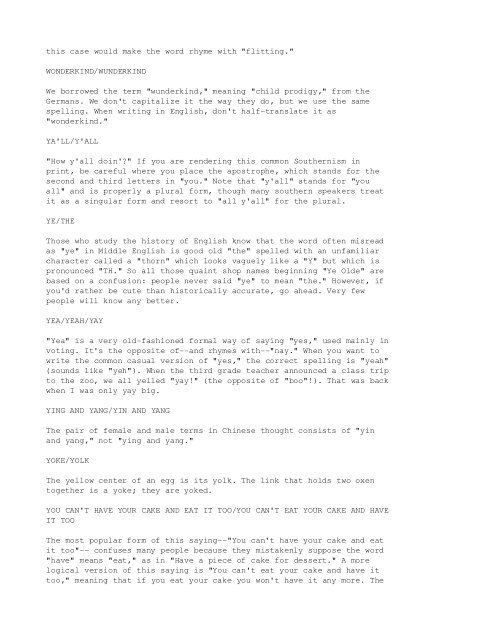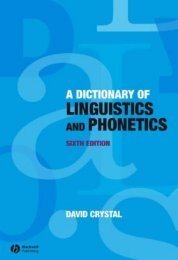Common_Errors_in_English_usage
Common_Errors_in_English_usage
Common_Errors_in_English_usage
Create successful ePaper yourself
Turn your PDF publications into a flip-book with our unique Google optimized e-Paper software.
this case would make the word rhyme with "flitt<strong>in</strong>g."<br />
WONDERKIND/WUNDERKIND<br />
We borrowed the term "wunderk<strong>in</strong>d," mean<strong>in</strong>g "child prodigy," from the<br />
Germans. We don't capitalize it the way they do, but we use the same<br />
spell<strong>in</strong>g. When writ<strong>in</strong>g <strong>in</strong> <strong>English</strong>, don't halftranslate it as<br />
"wonderk<strong>in</strong>d."<br />
YA'LL/Y'ALL<br />
"How y'all do<strong>in</strong>'?" If you are render<strong>in</strong>g this common Southernism <strong>in</strong><br />
pr<strong>in</strong>t, be careful where you place the apostrophe, which stands for the<br />
second and third letters <strong>in</strong> "you." Note that "y'all" stands for "you<br />
all" and is properly a plural form, though many southern speakers treat<br />
it as a s<strong>in</strong>gular form and resort to "all y'all" for the plural.<br />
YE/THE<br />
Those who study the history of <strong>English</strong> know that the word often misread<br />
as "ye" <strong>in</strong> Middle <strong>English</strong> is good old "the" spelled with an unfamiliar<br />
character called a "thorn" which looks vaguely like a "Y" but which is<br />
pronounced "TH." So all those qua<strong>in</strong>t shop names beg<strong>in</strong>n<strong>in</strong>g "Ye Olde" are<br />
based on a confusion: people never said "ye" to mean "the." However, if<br />
you'd rather be cute than historically accurate, go ahead. Very few<br />
people will know any better.<br />
YEA/YEAH/YAY<br />
"Yea" is a very oldfashioned formal way of say<strong>in</strong>g "yes," used ma<strong>in</strong>ly <strong>in</strong><br />
vot<strong>in</strong>g. It's the opposite ofand rhymes with"nay." When you want to<br />
write the common casual version of "yes," the correct spell<strong>in</strong>g is "yeah"<br />
(sounds like "yeh"). When the third grade teacher announced a class trip<br />
to the zoo, we all yelled "yay!" (the opposite of "boo"!). That was back<br />
when I was only yay big.<br />
YING AND YANG/YIN AND YANG<br />
The pair of female and male terms <strong>in</strong> Ch<strong>in</strong>ese thought consists of "y<strong>in</strong><br />
and yang," not "y<strong>in</strong>g and yang."<br />
YOKE/YOLK<br />
The yellow center of an egg is its yolk. The l<strong>in</strong>k that holds two oxen<br />
together is a yoke; they are yoked.<br />
YOU CAN'T HAVE YOUR CAKE AND EAT IT TOO/YOU CAN'T EAT YOUR CAKE AND HAVE<br />
IT TOO<br />
The most popular form of this say<strong>in</strong>g"You can't have your cake and eat<br />
it too" confuses many people because they mistakenly suppose the word<br />
"have" means "eat," as <strong>in</strong> "Have a piece of cake for dessert." A more<br />
logical version of this say<strong>in</strong>g is "You can't eat your cake and have it<br />
too," mean<strong>in</strong>g that if you eat your cake you won't have it any more. The





